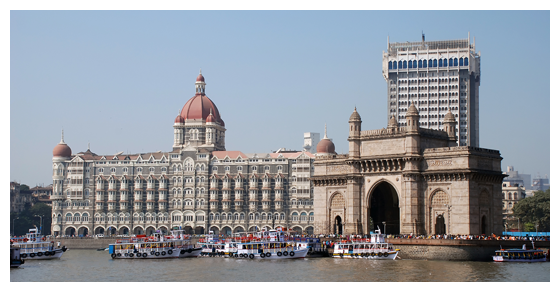
The Mumbai Attacks and Making Sense of Global Terror
When several gunmen swarmed India’s financial capital Mumbai and killed more than 160 people on November 26, 2008, the attacks played out across a spate of global media platforms. In news reports, a certain image of Mumbai emerged, one that placed the terrorists and victims within a larger meaning-making framework that reflected Western interests. During the subsequent weeks, as morearticles delved into the nature of the attacks, Mumbai and its citizens were defined through reports that directly transposed American interests onto the incident.
The Mumbai attacks are an important moment for the study of global terror, as the methods, motives, and coverage of the attacks marked changes in how international terrorism was represented. Recently published in Communication and Critical/Cultural Studies, my essay attempts to show how Western interests, through news reports published in Indian outlets, defined the popular terms for understanding both terrorism and reactions to it. Articles in The Times of India, Indian Express, and Daily News and Analysis created a context constructing Indian institutions, government officials, and civilians as reliant upon Western power to formulate a reaction to the attacks. Representations of Mumbai moved between general categories of victim and battle site; the city often became a character in the story, standing in for the human suffering felt by the victims of the violence. At other times, it symbolized the luxury historically associated with the city, taking on the character as an exoticized other when seen through the eyes of Westerners who appear in the news coverage. Throughout the coverage, an American-centric perspective emerges. Through this perspective, the significance of the attacks and possible reactions were constructed.
Take, for instance, an article focused on an American couple caught in the middle of the attacks while on a romantic holiday. “We didn’t see the terrorists, but we felt their rage,” read the headline, displaying an explicit admission that the emotional tenor of the attack would be filtered through American sensibilities. These two Americans operated as stand-ins for their entire country, judging the experience but also making the assertion that “despite their brush with terror, the couple is eager to ‘keep coming back’ to India, which is a ‘magical country.’” The couple’s impressionistic recollection lacks any tactical information because, as the headline indicates, they never saw the terrorists. Still, as Westerners, their perspective on the attacks appears newsworthy, anchoring an entire article built upon their perspectival authority as witnesses to a broader, cultural significance.
Mumbai is no stranger to terror. Bombings and assassinations fill the city’s history, but the news reports detail how these attacks are different in that they are an extension of global politics. The phrase “India’s 9/11” and reports documenting the attacks as “26/11” impart an idiom that explicitly defers to a global war on terror, invoking recent American political history to define the context of these attacks.
By conflating Mumbai with al Qaeda and 9/11, American officials quoted in the reporting claimed jurisdictional authority over the attacks. FBI sources were paraphrased as stating when Americans die in terrorist attacks abroad, the FBI has the responsibility to investigate, regardless of national sovereignty. Mumbai remained the stage upon which arguments about authority and response played out, as American bodies justified an American interest. The specific words of American law enforcement officials were not as important as their presence as news commentators celebrated the superior credibility of “U.S. intelligence” based upon America’s experience with terrorism, despite the fact that Mumbai had experienced three attacks from Islamic militants since 1993.
With Western experts controlling the interpretation of the attacks by citing privileged intelligence, these articles excluded Indian officials from having a say in how these attacks relate to Indian culture, politics, and history. Furthermore, the coverage operated with the assumption that al Qaeda’s ideology was subtly colonizing other groups, and that the only way to combat the spread was for countries experiencing terror to adopt an equally militaristic ideology, as exemplified by American foreign policy.
Still, an American-centric representation of the attacks was not the only one. Attempting to shake any post-colonial overtures, a single nameless Indian official asserted India’s authority in defining the attacks, stating simply, “This is a domestic issue. This is not India's 9/11.” Sweeping narratives that gave a global context to the attacks were shed as the attacks were constructed as a single political attack with the specific purpose to “disrupt any overtures to Pakistan and to ignite a backlash against Indian Muslims.” By limiting the scope of the attacks to a specific political conflict, the nameless official worked against other representations that imbued the attacks with a primarily Western significance. In this statement, terrorism loses a bit of its power to perpetuate broader conflict, as the motives behind the attack were overtly linked to the disruption of specific international policy goals.
The Mumbai attacks revealed the ways cities exist as ideological and material battle sites, how the media deals with international violence, and how the representation of 9/11 has become a reference point for reactions to terrorist attacks in other countries. The ways these attacks are represented in the media suggest ideological violence is built into the modern condition, and because of this, terrorism reverberates globally. Media texts and journalistic practices are a means of public knowledge production that construe acts of terror as moments worthy of international interest while also creating the terms that help audiences wade through the aftermath. By looking at news reports and media representations as the primary means for making sense of the attacks, we can begin to see how a predominantly Western and post-9/11 perspective has come to determine the way in which the world responds to terrorism, and, hopefully, offer practitioners an awareness that helps them look for alternative meanings that rely less on a perspective colored by strictly American interests.

